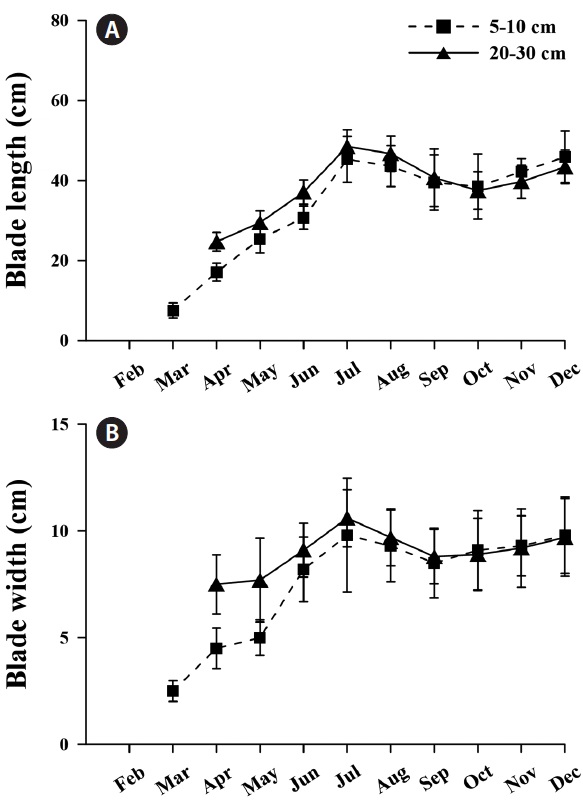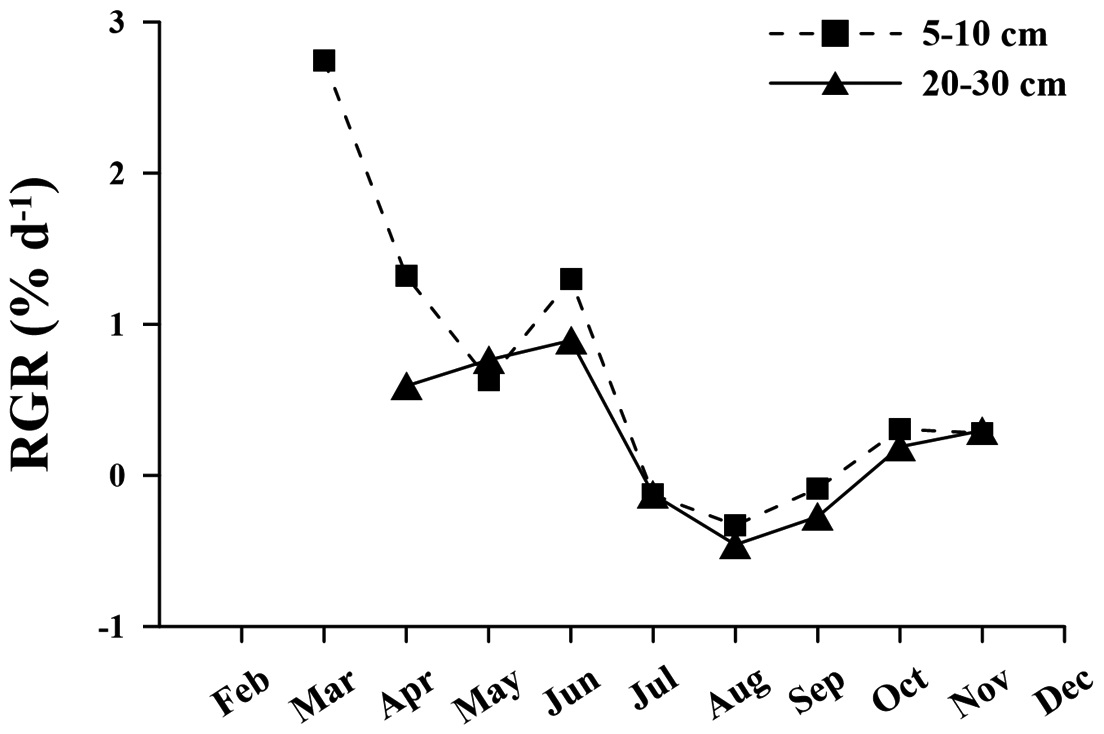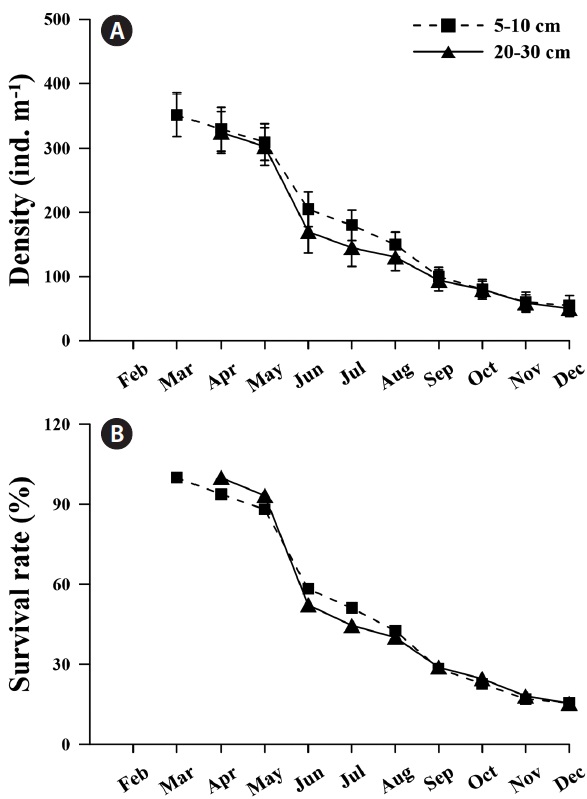Barren grounds are currently being expanded by destruction of seaweed habitats due to over harvesting, increases in herbivory (e.g., sea urchin and abalone) and sea temperature, and industrial pollution (Serisawa and Ohno 1995, Serisawa et al. 2002, 2003). The situations could lead to a decline in the fisheries of the country (Kim et al. 2006, 2007, 2010). It has been observed that both the diversity and biomass of seaweed species are declining in the coastal waters of Korea due to increasing occurrences in whitening event, changes in the oceanic conditions and increased number of grazers. Impacts of the expanded barren fields are particularly serious in waters off Jeju Island and the south and east coasts of the Korean peninsula (Choi et al. 2009, Kang 2010, Kim et al. 2012). For example, the barren area in the waters of Yeosu, South Sea of Korea, increased nearly 10 times for the past three years (70 ha in 2006 vs. 655 ha in 2009) (Kim et al. 2012). Approximately 31% of the southern coastal area in the East Sea (Gyeongbuk Province) is now identified as barren grounds. In Gangneung (Gangwon Province), approximately 7% of the coastal area has become barren (Kang 2010, Kim et al. 2012).
In Korea, rock scraping was used by fishermen to restore marine algal beds in barren grounds Those activities improved reproduction and growth of macroalgae like Undaria and Saccharina by removing barnacles, sponges and other competing organisms. Unfortunately, however, the rock scraping technique could only work in areas where macroalgae had already grown abundantly. Thus, some of local communities initiated the so called reforestation programs to revive the open area. The communities commonly carried out the programs by seeding meiospores of Saccharina japonica on seed strings called “cremonasa,” winding the strings with seaweed growing on them around a cloth braided rope (15-20 mm in diameter) and then tying the cloth rope onto an artificial seaweed reef. However, the cloth ropes were easily broken by strong tides and waves, preventing Saccharina from taking root, and they mostly failed to grow or survive (Kim et al. 2007). During the past few decades, researchers in Korea and Japan have developed transplantation techniques to create marine forests (Choi et al. 2002, Kim et al. 2007). Serisawa et al. (2002, 2003) developed a technique for Ecklonia cava in which it was transplanted onto small concrete tiles (10 cm length × 10 cm width × 0.4 cm height). In other studies, researchers attached E. stolonifera onto bedrocks using instant glue (Choi et al. 2002).
As these plantation systems use light-weighted structures, the techniques cannot be applied to the East (Japan) Sea of Korea with exposure to high waves. The East Sea is wide open and constantly receiving very strong waves (Jeong et al. 2007, Kim and Lee 2008). This area is hit by at least several typhoons every year, which make it almost impossible to use light-weighted transplantation structures (Choi et al. 2002, Serisawa et al. 2002, 2003). To overcome the obstacle, the East Sea Fisheries Research Institute, National Fisheries Research and Development Institute (NFRDI) has recently developed a technology to deploy artificial reefs in East Sea in an efficient and cost-effective way (Kim et al. 2012).
Ecklonia cava, perennial kelp, grows in a subtidal range from 2 to 30 m deep in the waters (Iwahashi et al. 1979). This species grows as long as 2 m (Hayashida 1977, 1986). New blades are generated during the winter. Blades get wider in spring and thicker in summer (Yokohama et al. 1987, Chung et al. 2013). E. cava sporophytes were successfully transplanted in 2005 to a barren ground in Imwon, Samcheok City, Gangwon Province, Korea, using the newly developed transplantation technique (Kim et al. 3662012). These transplants successfully grew on the artificial reefs and even produced sporelings on the reef and adjacent rocky substrata. However, these artificial reefs (3.0 m length × 3.5 m width × 1.1 m height and a weight of 4.6 tons) (Kim et al. 2012) were affected by grazing invertebrates, such as sea urchins (Strongylocentrotus nudus, S. intermedius, Hemicentrotus pulcherrimus), and mollusks (Chlorostoma turbinate, Haliotis gigantea). In the present study, modified artificial reefs were developed to overcome this grazing issue. The objective of this study was to determine the optimal plant size and timing for transplantation of E. cava seed-stock using the modified artificial stepped reef structure.
The study was conducted in a research fishing ground operated by East Sea Fisheries Research Institute (ESFRI) which is located at Imwon, Samcheok City, Gangwon Province (37°13′47.03″ N, 129°20′52.05″ E). In February 2007, 14 units of the modified artificial stepped reefs were placed on the bedrock of 7-8 m depth in barren ground site at Imwon using a barge. The modified stepped artificial reef in the present study was 3.5 m width × 3.0 m length × 1.12 m height and a weight of 12.7 tons. This heavy reef provided a more stable platform under tough water conditions than had been used previously (Kim et al. 2012). The taller stepped structure reduced invertebrate access. Finally, the stepped structure also created a nursery environment for juvenile finfish and reduced the impact of strong waves. Ecklonia cava sporophytes were transplanted onto the artificial step seaweed reefs in February (1-2 cm), March (5-10 cm), and April (20-30 cm in length). The 1-2 and 5-10 cm size classes had average 1.5 ± 0.9 and 7.5 ± 1.9 cm in length, and 1.2 ± 0.7 and 2.5 ± 0.4 cm in width, respectively. For the size class of 20-30 cm, the length and width were 24.7 ± 2.3 and 7.5 ± 1.4 cm, respectively. The blade length, width and density were measured monthly from February to December 2007 by scuba divers. To measure the density, divers counted the number of blade per 1 meter of the seaweed rope (m-1). The relative growth rate (RGR) of transplanted E. cava was calculated using the following equation (Hoffmann and Poorter 2002).
RGR (d-1) = (lnL2 - lnL1) / (t2 - t1)
, where L1 and L2 are length at times t1 and t2.
For repeated measures, ANOVA was used to evaluate
the influence of the blade size (plantation time) on the growth of E. cava. When ANOVA indicated treatment effect of blade size, Turkey’s HSD analysis (α = 0.05) was used as a post hoc test to determine pair wise comparisons of treatment means. All statistical analyses were done using STATISTICA version 7.0 (Statsoft Inc., Tulsa, OK, USA).
Ecklonia cava sporophytes of <1 cm in length died within one month of being transplanted on the artificial reef (Fig. 1). This was probably due to an over population of sea urchins (Strongylocentrotus nudus, S. intermedius, and Hemicentrotus pulcherrimus) (Graham 2004, Ling et al. 2010). Similarly destroyed was observed Laminaria species by sea urchin grazing (Kain 1979). However, the blades 5-10 cm in length, transplanted in March, survived and grew on the reef (Figs 2 & 3). Both the size classes of 5-10 and 20-30 cm in length grew until June with size reductions being reported starting September (Figs 1 & 2). From October, the size class of 5-10 cm began to grow faster than the 20-30 cm blades and the former group was recorded at 45.9 ± 9.1 cm, surpassing the latter with 43.4 ± 9.5 cm in December. The size class of 5-10 cm in length showed the highest growth rate (2.74% d-1) in March, then decreased to 1.32% d-1 in April, 0.63% d-1 in May and recovered to 1.29% d-1 in June, while the growth rates of the size class of 20-30 cm kept <1% during the period of from April to June (p < 0.001) (Fig. 2). E. cava sporophytes of both size classes showed negative growth rates from July to September due to the blade edge erosion (Fig. 1). Serisawa et al. (2003) also showed that smaller blades (<20 cm in length) grew faster than larger ones when compared among different size classes of E. cava (approximately 10-40 cm in length) transplanted on an artificial reef. These results indicate an advantage of using smaller blades of E. cava for successful transplantation onto artificial seaweed reef. In addition, smaller E. cava plants are easier to maintain and cheaper to buy. On the contrary, managing of larger blades (c.a. 20-30 cm in length) is difficult especially during plant loss in the process of forestation. These blades are also more expensive. The both size classes (5-10 and 20-30 cm in length) did not show any difference in survival (Fig. 3). The survival rate of 5-10 cm blades was approximately 95% in April. The survival rate of both size classes were respectively 88 and 93% in May, then decreased to 16% and 15% in December (Fig. 3B). In both size classes, the density also decreased from 352 m-1 in March to 180 m-1 in July and from 325 m-1 in April to 145 m-1 in July (Fig. 3A).
The sporophytes of E. cava grow in winter and spring. They reach their maximum size in late spring and early summer, and then biomass reductions occur in the summer season (Kain 1991). For example, the meiospores of E. cava planted on biodegradable ropes which were deployed at 12 m depth in May, grew to 15 cm by July, but decreased to 11 cm by August (Beak et al. 2009). Kim et al. (2012)
also showed that sporophytes of E. cava with 7.2 cm blade length which were transplanted in February 2005 grew to 36 cm in length by July. Thereafter, the blades size decreased to 19 cm by October due to blade erosion. Our study also showed a similar seasonal growth pattern (Fig. 1). These results suggest that elevated sea temperatures (Park et al. 2004) may have been causing the more severe erosion and deterioration continuously, thus, speeded up the expansion of the barren grounds along the Korean Peninsula.
The findings from the present study showed the importance of size and timing determination for E. cava transplantation on artificial reefs to recover barren grounds. From the study, we found the optimal size and timing to be 5-10 cm and around March, respectively.
We have developed the marine forest enhancement technique based on seed transplantation for rehabilitating coastal ecosystems. According to the trials on the optimal size and timing for the seed transplantation, the size class of 5-10 cm in length recorded the highest growth rate (2.74% d-1) in March, then decreased to 1.32% d-1 in April and 0.63% d-1 in May before recovering to 1.29% d-1 in June. It was also observed that the survival rate of 5-10 cm blades was approximately 95% in April. The survival rate of the both size classes were respectively 88% and 93% in May, then decreased to 16% and 15% in December. The study also suggests that the modified artificial stepped reef, which can resist typhoons and swells occurring in the East Sea, can be applied along all the coasts of the country. It is thus considered that the marine forest enhancement technique and the modified artificial stepped reef applied in this study should be very useful for the large scaled marine forest enhancement project which is being carried out by the government.






